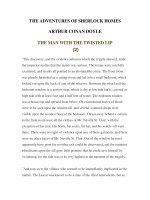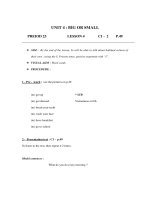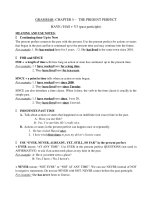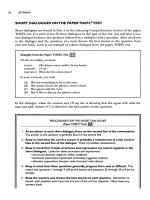4 6 2 the sauk and fox
Bạn đang xem bản rút gọn của tài liệu. Xem và tải ngay bản đầy đủ của tài liệu tại đây (2.84 MB, 12 trang )
Suggested levels for Guided Reading, DRA,™
Lexile,® and Reading Recovery™ are provided
in the Pearson Scott Foresman Leveling Guide.
The
Sauk and Fox
by Lillian Forman
illustrated by Dan Bridy
Genre
Expository
nonfiction
Comprehension
Skills and Strategy
• Fact and Opinion
• Plot and Theme
• Text Structure
Text Features
• Captions
• Glossary
Scott Foresman Reading Street 4.6.2
ISBN 0-328-13490-2
ì<(sk$m)=bdejai< +^-Ä-U-Ä-U
Reader Response
The
Sauk and Fox
1. Facts are statements that can be proven. Opinions
are what someone thinks or believes. Reread page
10 to find a statement of fact and a statement of
opinion. Write them in a chart similar to the one
below.
Fact
by Lillian Forman
Opinion
illustrated by Dan
Bridy
2. On page 7 through page 9, the author compares
and contrasts the roles of Sauk and Fox men and
women during the 1600s and 1700s. What did you
learn from these comparisons?
3. Look at the word reservation in the Glossary.
Give one other meaning for the word. Use it in a
sentence.
4. Use the picture on page 6 to tell about the daily
life of the Sauk and Fox.
Editorial Offices: Glenview, Illinois • Parsippany, New Jersey • New York, New York
Sales Offices: Needham, Massachusetts • Duluth, Georgia • Glenview, Illinois
Coppell, Texas • Ontario, California • Mesa, Arizona
Saturday, July 27, 1912, was a great day for all
Americans—especially Native Americans. On that
day, King Gustav V of Sweden told a young Sauk
and Fox Indian, Jim Thorpe, that he was “the
greatest athlete in the world.” Thorpe had just
won a gold medal in two track and field events
in the 1912 Olympics.
The events included track and field contests,
such as jumping over hurdles, running races,
throwing a javelin (which is similar to a spear),
and throwing a shot put (a heavy metal ball).
These events tested Jim Thorpe’s skill and
endurance.
Every effort has been made to secure permission and provide appropriate credit for
photographic material. The publisher deeply regrets any omission and pledges to
correct errors called to its attention in subsequent editions.
Unless otherwise acknowledged, all photographs are the property of Scott Foresman,
a division of Pearson Education.
Photo locators denoted as follows: Top (T), Center (C), Bottom (B), Left (L), Right (R),
Background (Bkgd)
Illustrations by Dan Bridy
3 Corbis; 4 Corbis; 5 (Bkgd) John Fitzpatrick/Library of Congress, (C) Frances
Benjamin Johnston/Library of Congress; 8 (BL) Frank Albert Rinehart/Smithsonian
National Anthropological Archives, (BR) Charles Milton Bell/Smithsonian National
Anthropological Archives; 9 Denver Public Library, Western History Collection;
12 Corbis; 18 (T, C) Denver Public Library, Western History Collection; 19 Lindsay
Hebberd/Corbis
ISBN: 0-328-13490-2
Copyright © Pearson Education, Inc.
An Olympic gold medal
All Rights Reserved. Printed in the United States of America. This publication is
protected by Copyright, and permission should be obtained from the publisher
prior to any prohibited reproduction, storage in a retrieval system, or transmission
in any form by any means, electronic, mechanical, photocopying, recording, or
likewise. For information regarding permission(s), write to: Permissions Department,
Scott Foresman, 1900 East Lake Avenue, Glenview, Illinois 60025.
2 3 4 5 6 7 8 9 10 V0G1 14 13 12 11 10 09 08 07 06 05
3
Americans were happy with Thorpe’s athletic
skills. He had beaten other athletes in events that
called for many different talents.Thorpe’s fellow
Native Americans felt that he helped them gain
the respect of other Americans. Native Americans
have had a history of being unfairly treated in
the United States.
In the 1800s the U.S. government sent people
to explore and claim land in the western United
States. Native American nations were already
living in the West. The U.S. government
took their land and in exchange,
gave Native Americans pieces
of land set aside for them.
Such a piece of land is
called a reservation.
Unfortunately, Native
Americans had
trouble farming
or hunting
on these
reservations.
As a result, many Native Americans were
poor. Many depended on help from the U.S.
government. This gave the government control
over the Native Americans. It encouraged them
to send their children to boarding schools. The
students lived there during the school term. They
ate in a dining hall and slept in a dormitory.
The students learned English and other
subjects. They also learned to do different kinds
of manual work. The teachers did not allow the
Native American students to speak their native
languages.
Jim Thorpe throwing
the shot put
Boarding school for Native Americans
4
5
The Sauk and Fox—also known as the
Mesquaki—were once separate Indian groups,
but they had similar cultures. In the 1600s and
1700s, the Sauk and Fox lived in Michigan,
Wisconsin, Illinois, Iowa, and Missouri. The two
groups lived in villages near one another. They
traded, visited, and learned each other’s ways.
Their villages were similar. The village shown
on page 6 could have belonged to either the
Sauk or the Fox. Wide streets separated the
houses from the fields where crops were planted.
The houses were long, wooden buildings
called lodges. Several families that were closely
related to each other lived in one lodge. People
gathered in the wide streets to chat or to
trade goods. The open spaces were used for
ceremonies, dances, and sporting contests.
The areas where the two groups lived had rich
soil and lots of rain. The Sauk and Fox women
were the farmers of their communities. They
planted large crops of corn, beans, pumpkins,
melons, and squashes. They gathered wild plants
that could be used for food or medicine. The
men hunted animals and fished. The Native
Americans ate the animals they hunted. They
also used animal skins and bones for clothes and
tools.
Sauk and Fox villages looked similar to this.
6
7
Men and women each played different and
important roles in the Sauk and Fox communities.
One of the women’s jobs was caring for their
children. Farming was a good job for women
because the fields were near the village.
Gathering plants was fitting because the children
could come with their mothers to nearby woods
and prairies. Women also did tasks that could be
done in or near the lodges. They cooked meals
and made clothes and blankets from the skins of
the animals killed by the men.
The women’s jobs included
taking care of the children
and farming.
Sauk and Fox man, woman, and baby
Men were the hunters, traders, and warriors.
Men’s jobs took them far from the village for
long periods of time. Men met people from
different Native American groups on hunting
and trading trips. Sometimes they disagreed with
other Native Americans about which group had
the right to hunt in certain places. They got into
fights. That is why men also needed to be trained
as warriors.
8
9
Some men were chiefs. Each Sauk and Fox
community had a peace chief and war chiefs.
People came to the peace chief for advice about
all kinds of community problems. They asked for
help in solving problems with neighbors. A peace
chief was kind and fair. He had to know all the
traditions of his community and have a good
understanding of his people. He could not force
anyone to do anything. He gained respect by
setting a good example.
War chiefs
The role of the war chiefs was different from
that of the peace chief. The Sauk and Fox war
chiefs planned raids against rivals. They also
planned ways to protect their nations from
attack. Only the best warriors could become war
chiefs.
Some men were peace chiefs, and some were war chiefs.
10
11
Only men who the members of the group
thought would make good leaders could become
peace chiefs. Sauk and Fox chiefs could try to
pass the office on to their sons, but the members
had the final say.
Sauk and Fox women could not be chiefs.
But they still played important roles in their
communities. As farmers, they brought in much
of the nation’s food. They made clothing and
other items for the nation. They took care of
other women during childbirth. Sauk and Fox
women were highly valued.
12
Men and women worked together in their communities.
Family was very important to the Sauk and
Fox people. Their society, or people who lived
together, was based on family relationships.
People belonged to groups called clans. Each
clan had special religious objects. Twice a year,
clan members would join together to perform a
ceremony that honored these sacred objects.
13
The Sauk and Fox believed that spirits were
important. The chief of these spirits was called
the Great Manitou. He was believed to be the
creator and controller of the world. Each person
and every animal were also thought to have
manitous of their own.
The Sauk and Fox people believed that these
spirits of nature could protect them. Sometimes
they saw and spoke to spirits in dreams.
Often they tried to get in touch with them
by performing ceremonies. Religious leaders
called medicine men helped them perform the
ceremonies.
There were many ways in which the Sauk
and Fox showed their religous beliefs. Just as
the spirits in nature could help humans, humans
helped each other. They shared food and other
goods with the needy. They worked with each
other. They tried to show each other respect.
Medicine man
14
15
European people began to settle Sauk and
Fox land in the 1800s. The Sauk and Fox decided
to move to new areas. Then they began to
resist the settlers. They struggled to keep their
homeland. The Sauk and Fox became close allies,
or partners.
The U.S. government sent in soldiers with
modern weapons. The soldiers defeated the
Native Americans. The Native Americans knew it
was useless to resist.
Troops sent by the U.S. government had
forced most of the Sauk and Fox people out
from where they lived in Illinois. By 1870 most
Sauk and Fox people had moved to Iowa and
Oklahoma. A few years later, they were forced
to move to Kansas. At this time the Sauk and Fox
began to unite into a single nation.
Soldiers build forts near Sauk and Fox villages.
16
17
Sauk and Fox children in
school uniforms
As you learned, the U.S. government
controlled what Native American children
studied in their boarding schools. The
government also tried to change the way the
adults lived. It divided the reservation land
among individuals and single families. The land
no longer belonged to the whole nation. Still,
the Sauk and Fox people hung onto their culture.
Perhaps Jim Thorpe’s success in the Olympic
games helped give them courage.
18
Today the Sauk and Fox have more control
over how they live. Farming is no longer their
only means of making a living. Some even live
outside the reservation.
The Sauk and Fox are learning skills for a
variety of jobs. They go to meetings to make
decisions about how to govern their reservation.
They hold their traditional ceremonies. Their
children can once again learn the Sauk and Fox
language and listen to their elders tell them
stories from the past.
Traditional headdress
19
Glossary
boarding schools n.
schools with buildings
where the pupils live
during the school term.
dormitory n. a building
with many rooms in
which people sleep.
endurance n. power to
last and to withstand
hard wear.
Reader Response
manual adj. done with
the hands.
reservation n. land
set aside by the
government for a
special purpose.
society n. the people of
any particular time or
place.
1. Facts are statements that can be proven. Opinions
are what someone thinks or believes. Reread page
10 to find a statement of fact and a statement of
opinion. Write them in a chart similar to the one
below.
Fact
Opinion
2. On page 7 through page 9, the author compares
and contrasts the roles of Sauk and Fox men and
women during the 1600s and 1700s. What did you
learn from these comparisons?
3. Look at the word reservation in the Glossary.
Give one other meaning for the word. Use it in a
sentence.
4. Use the picture on page 6 to tell about the daily
life of the Sauk and Fox.
20









